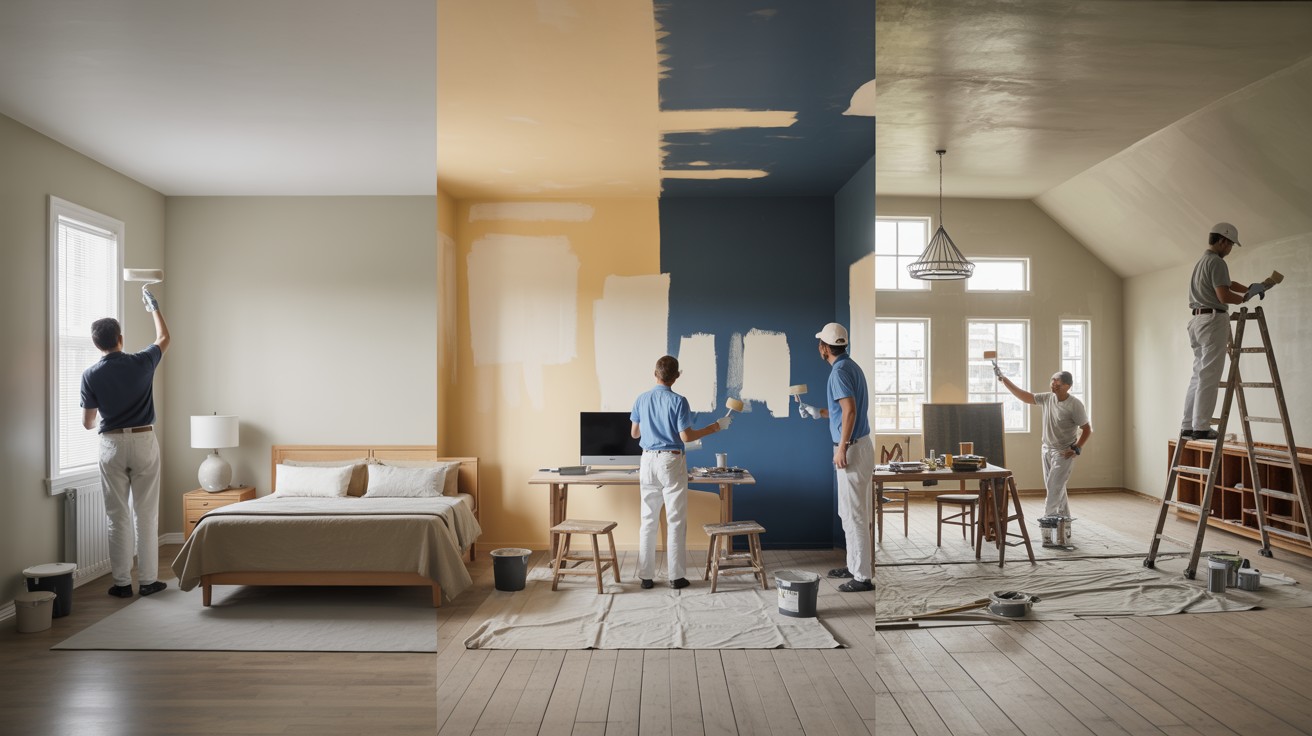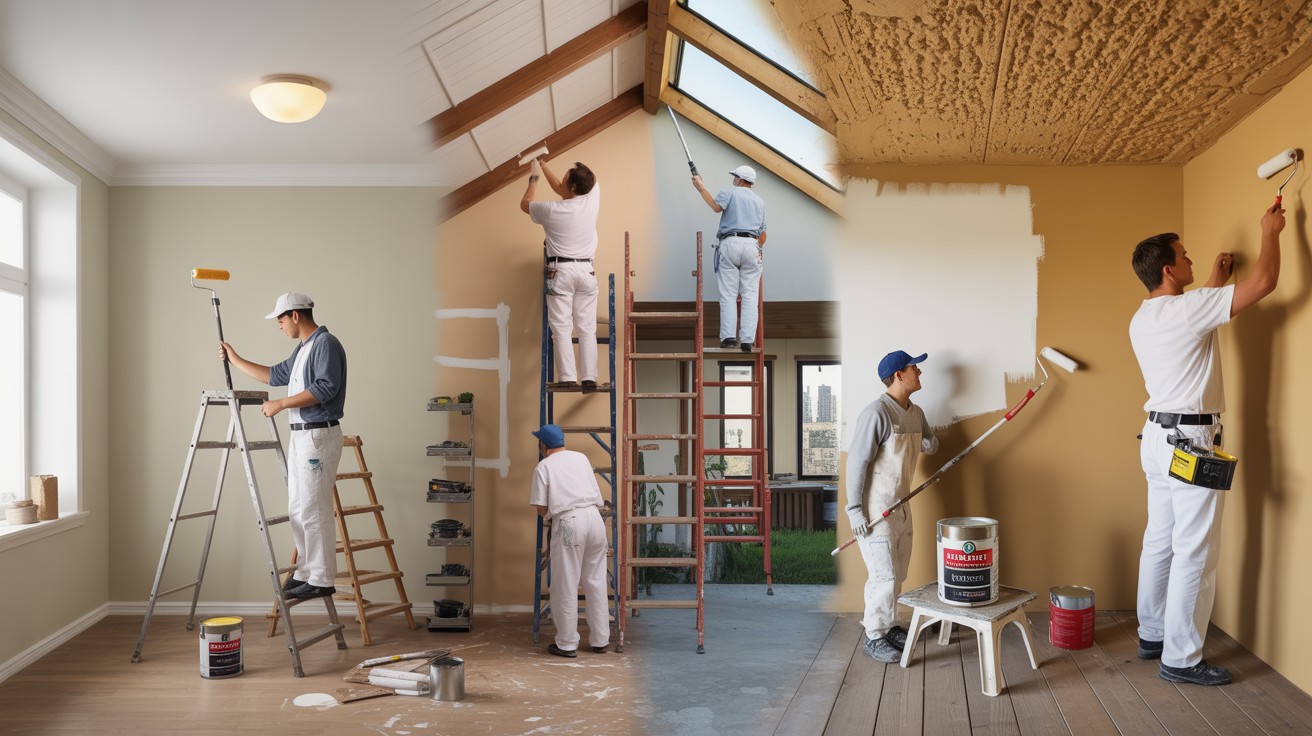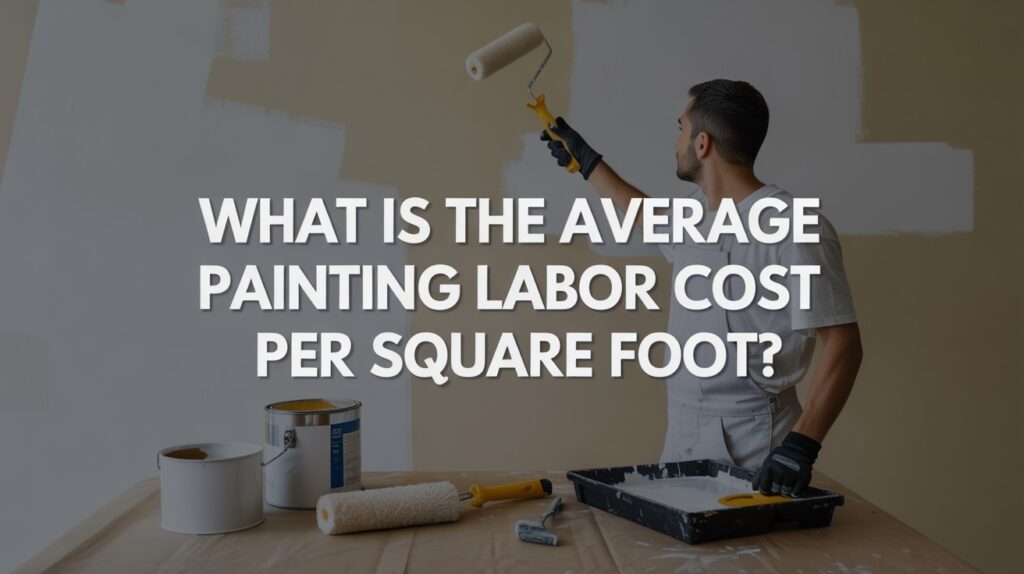A fresh coat of paint can significantly increase your home’s value, making it one of the most cost-effective home improvement investments available.
However, before hiring professional painters, understanding labor costs per square foot helps you budget accurately and make informed decisions about your project.
This comprehensive guide examines painting labor rates based on room dimensions, service types, and various factors that influence final pricing.
From interior wall refreshes to complete exterior makeovers, labor costs vary considerably depending on project scope and complexity.
Additional considerations like surface preparation, paint quality, and regional market rates all play roles in determining your total investment.
Armed with this knowledge, you can confidently approach contractors, compare quotes effectively, and ensure your painting project stays within budget while achieving the results you want.
Understanding Painting Labor Costs

Professional painting labor encompasses comprehensive services from surface preparation to final cleanup, with national rates varying between wall coverage and floor space pricing methods.
What Does Labor Cost Include?
Professional painting services cover comprehensive work beyond basic paint application.
Labor costs include preparation work such as masking, taping, and sanding surfaces for proper adhesion.
Contractors also handle moving and covering furniture to protect your belongings while providing clear workspace access.
Wall repair and priming address existing damage before painting begins. This involves filling holes, repairing cracks, and applying primer for uniform coverage.
The actual paint application covers walls, ceilings, and trim work with proper cutting-in and multiple coats as needed.
Clean-up and furniture reset complete the service. Painters dispose of materials, clean equipment, remove protective coverings, and return furniture to original positions, leaving your home immediately usable.
National Average Labor Cost Per Square Foot
Painting contractors typically use two pricing methods for residential projects.
Wall coverage area pricing ranges from $1 to $3 per square foot of paintable surface, calculating costs based on actual wall area requiring paint coverage.
Floor space pricing ranges from $3 to $7 per square foot of room floor area. This method considers total room size rather than specific wall measurements.
Contractors often prefer this simpler approach, though rates appear higher since floor measurements are typically smaller than corresponding wall areas.
Cost Breakdown by Measurement Type

Understanding how painters calculate their fees helps homeowners make informed decisions when planning their next painting project. Professional painters typically use three main pricing methods, each suited to different types of work and project scopes.
Per Square Foot of Coverage Area
This measurement focuses specifically on the surfaces that receive paint application. When painters use this method, they calculate costs based solely on walls, excluding other room elements.
This approach works best for straightforward wall painting projects where homeowners want to refresh existing paint or change colors in specific rooms. The typical cost ranges from $1 to $3 per square foot of wall surface.
Property owners find this pricing method particularly helpful when comparing quotes from different contractors for interior room makeovers.
Since the calculation excludes additional elements like trim work or ceiling painting, it provides a clear baseline for wall-focused projects.
Per Square Foot of Floor Space
This comprehensive pricing approach accounts for complete room transformation. Contractors using this method base their estimates on the room’s floor area while including all paintable surfaces within that space.
The average cost typically falls between $3 and $7 per square foot of floor space. This range reflects the additional work involved in painting ceilings, baseboards, trim, doors, and other architectural details throughout the room.
Homeowners planning complete room renovations often prefer this pricing structure because it provides a single, all-inclusive rate. This method eliminates the need to calculate separate costs for different room components, making budget planning more straightforward.
Per Hour Labor Rates
Some painting professionals prefer charging based on time investment rather than square footage. This approach allows for more flexibility when dealing with complex projects that require extra attention to detail.
Professional painters typically charge between $20 and $50 per hour for their services. Several factors influence where a painter’s rate falls within this range, including their years of experience, local market conditions, and the specific challenges your project presents.
Hourly billing works particularly well for projects involving intricate detail work, multiple color applications, or challenging surfaces that require special preparation techniques.
This pricing method ensures painters receive fair compensation for time-intensive tasks that might be undervalued in square-footage calculations.
Labor Cost Examples by Room Size

Planning your painting budget becomes much easier when you understand typical labor costs for different room sizes. Here are realistic examples based on common residential spaces to help you estimate expenses for your project.
Small Bedroom (10×10)
A standard small bedroom typically contains between 320 and 350 square feet of paintable wall surface. This calculation includes all four walls while accounting for windows, doors, and other openings that reduce the total area requiring paint coverage.
Labor costs for this size room generally range from $320 to $1,050, depending on the number of paint coats needed. Single-coat applications fall on the lower end of this spectrum, while projects requiring two or three coats for optimal color coverage and finish quality reach the higher end.
The variation in pricing also reflects differences in wall condition, paint type selection, and any necessary surface preparation work before painting begins.
Medium Room (12×12 or 12×15)
Medium-sized rooms, whether square or rectangular layouts, typically contain 350 to 450 square feet of wall surface area. These spaces might serve as master bedrooms, home offices, or formal dining rooms.
Expected labor costs range from $350 to $1,350 for complete wall painting. The price variation depends on factors such as existing wall condition, desired finish quality, and the number of paint coats required to achieve the intended color and coverage.
Rooms with higher ceilings, built-in features, or architectural details may fall toward the upper end of this cost range due to additional time requirements for proper preparation and application.
Living Room (Large, 400+ SF)
Large living spaces present more complex pricing scenarios due to their size and typical architectural features. These rooms often include vaulted ceilings, multiple windows, built-in shelving, or open floor plans that connect to other areas.
Total project costs typically range from $600 to over $2,000, reflecting the comprehensive nature of these painting jobs. This pricing usually includes ceiling work and trim painting in addition to wall surfaces.
The significant cost variation reflects differences in room complexity, ceiling height, architectural details, and the level of prep work required. Open-concept spaces that flow into kitchens or dining areas may require additional coordination and masking to protect adjacent surfaces, contributing to higher labor costs.
Factors That Affect Painting Labor Costs

Several key variables influence how much you’ll pay for professional painting services. Understanding these factors helps you anticipate costs and make informed decisions about your project scope and timeline.
Ceiling Height and Surface Complexity
Standard 8-foot ceilings allow painters to work efficiently with basic equipment. However, rooms with 9-foot, 10-foot, or higher ceilings require additional setup time, specialized ladders, and more careful safety precautions.
Textured surfaces add significant complexity to any painting project. Popcorn ceilings, knockdown textures, and heavily textured walls require more paint and additional application time to ensure complete coverage in all the surface grooves and raised areas.
Vaulted and cathedral ceilings present the greatest challenge for painters. These architectural features often require scaffolding or specialized equipment, extending project timelines and increasing labor costs substantially compared to flat ceiling applications.
Number of Coats
Paint application time increases directly with the number of coats required. Most professional jobs involve at least two coats for optimal coverage and color consistency, but some situations demand additional applications.
Dramatic color changes, particularly when going from dark to light colors, often require primer plus two or more finish coats. This process ensures the new color appears true to its intended shade without the underlying color showing through.
Some paint types and color combinations naturally require multiple coats to achieve manufacturer-recommended coverage levels, regardless of the existing wall color underneath.
Paint Type and Drying Time
Oil-based paints demand more careful application techniques and longer drying periods between coats. Painters must allow adequate time for proper curing, which can extend project timelines and increase labor costs.
Water-based latex paints dry faster and clean up more easily, allowing painters to work more efficiently. However, these paints sometimes require additional coats to achieve the same coverage density as oil-based alternatives.
The choice between paint types affects not only application time but also the number of coats needed, creating a compound effect on total labor costs.
Regional Pricing Variations
Urban markets typically command higher labor rates due to increased living costs and stronger demand for professional services. Major metropolitan areas often see rates 20-50% above rural or suburban markets.
Local contractor availability significantly impacts pricing. Areas with high construction activity or limited numbers of qualified painters may experience elevated rates due to increased competition for skilled labor.
Economic conditions, seasonal demand, and local regulations also contribute to regional price differences, making it important to obtain multiple local quotes for accurate budget planning.
How to Estimate Your Painting Labor Cost

Calculating painting labor costs before contacting contractors helps you set realistic budget expectations and evaluate quotes more effectively. This straightforward approach provides reliable estimates for most standard residential rooms.
Quick Room Estimate Formula
Getting an accurate labor estimate requires just four simple calculations that any homeowner can complete with basic measuring tools.
Start by measuring your room’s perimeter. Walk around the space and record the length of each wall, then add these measurements together for your total perimeter distance.
Next, multiply this perimeter measurement by your ceiling height to determine total wall square footage. Most residential rooms have 8-foot ceilings, though some homes feature 9-foot or 10-foot heights.
Account for areas that don’t require paint by subtracting space occupied by windows and doors. A standard calculation uses 37 square feet as the average combined area for one door and one window, though you can measure these openings individually for greater precision.
Finally, multiply your adjusted wall area by the typical labor rate range of $1 to $3 per square foot. This calculation provides your estimated labor cost range for the project.
Example Estimate – 10×12 Room
This practical example demonstrates how the formula works with real measurements from a common bedroom size.
A 10×12 room has walls measuring 10 feet, 12 feet, 10 feet, and 12 feet, creating a 44-foot perimeter. With standard 8-foot ceilings, the total wall area equals 44 multiplied by 8, resulting in 352 square feet.
Subtracting 37 square feet for one door and one window opening leaves 315 square feet of paintable wall surface.
Applying the $1 to $3 per square foot labor rate range, this room would cost between $315 and $945 for professional painting services.
The final price within this range depends on factors like paint quality, number of coats required, and regional labor rates in your area.
This estimation method works well for budget planning, though final quotes from contractors may vary based on specific project requirements and local market conditions.
Tips to Save on Painting Labor Costs
Reduce your painting expenses with these practical strategies that maintain quality while cutting costs.
Do the Prep Work Yourself
Handle basic preparation tasks to reduce billable hours.
Move furniture to room centers and cover with protective materials. Patch small nail holes and minor wall damage using basic spackling compounds from hardware stores.
Remove outlet covers, switch plates, and cabinet hardware before painters arrive, keeping pieces organized in labeled bags for easy reinstallation.
Schedule Multiple Rooms Together
Combine several rooms into one project for bulk pricing advantages. Contractors offer better per-room rates with guaranteed work volume.
This approach reduces setup time and equipment trips, creating efficiency savings that benefit both parties.
Coordinated scheduling also allows for better color planning and bulk paint purchasing.
Hire During Off-Peak Seasons
Time your project strategically for better rates. Winter and early spring offer the best pricing when contractor demand decreases.
Off-peak scheduling provides more availability, flexible timing, and competitive rates. Avoid late spring and summer when both interior and exterior painting demand peaks, driving up costs and reducing contractor availability.
Conclusion: Know the Labor Cost Before You Paint
Understanding average painting labor cost per square foot gives you the knowledge needed to budget effectively and avoid excessive charges.
When planning to paint one room or your entire home, familiarity with labor pricing structures helps you make confident hiring decisions while keeping costs reasonable.
Armed with pricing information for different measurement methods, room sizes, and cost factors, you can evaluate contractor quotes objectively.
Use the estimation formulas provided to calculate expected expenses before meeting with professionals.
Remember that preparation work, strategic scheduling, and off-peak timing can reduce your total investment significantly.
Smart homeowners research labor costs first, then hire contractors who offer fair pricing and quality workmanship for their painting projects.
Frequently Asked Questions
What is the typical cost range for painting labor per square foot?
Painting labor costs typically range from $1 to $3 per square foot for wall coverage only. For comprehensive room painting including ceilings, trim, and doors, expect $3 to $7 per square foot of floor space.
How do painters calculate labor costs for different room sizes?
Most painters use either wall square footage, floor square footage, or hourly rates for pricing. Small bedrooms (10×10) cost $320-$1,050, while medium rooms (12×12) range from $350-$1,350 for complete labor.
What factors increase painting labor costs the most?
Ceiling height and surface complexity significantly impact pricing, especially vaulted ceilings requiring special equipment. Multiple paint coats, dramatic color changes, and oil-based paints also increase labor time and costs.
Can I reduce painting labor costs without sacrificing quality?
Yes, handle preparation work yourself by moving furniture, patching small holes, and removing hardware. Schedule multiple rooms together for bulk pricing and hire during off-peak seasons like winter for better rates.
How accurate are DIY painting cost estimates?
DIY estimates using the perimeter × height formula provide reliable baseline calculations for budget planning. While contractor quotes may vary based on specific requirements, this method gives you realistic expectations for most standard residential rooms.

